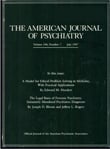TO THE EDITOR: We read the recent article on olanzapine by Gary D. Tollefson, M.D., Ph.D., and colleagues (
1) and wish to comment on several issues. The authors' methodological choices were interesting. Combining patients from distinct diagnostic groups and of different severity levels can lead to analytic difficulties. Also, patient exclusion criteria were not listed. Were patients with comorbid substance abuse or who were taking depot antipsychotic medications excluded from the study? While we appreciate the goal of demonstrating efficacy in a diverse group of patients, pooling data from several distinct groups opens the possibility that important findings will be overlooked.
Another issue is the relatively high fixed-dose haloperidol regimen, which may have contributed to extrapyramidal side effects and negative symptoms. Was there an impact from including patients with a prior poor response to oral or depot haloperidol? Is it possible that patients with recent-onset schizophrenia were given excessive doses of haloperidol (
2), while chronically ill patients were treated with a medication that was already known to be ineffective?
While we are curious about these issues, a more serious problem is this study's single-blind design, which made considerable use of clinician-gathered data for primary endpoint determination. Were these nonblind clinicians more likely to identify side effects from the familiar haloperidol than the unfamiliar olanzapine? The absence of a discussion on interrater reliability also caught our attention.
The methodologically superior article by Tollefson and Sanger (
3) displayed considerable scientific skill, which leads us to wonder anew about the flaws of the first study. Perhaps the authors have a responsibility to promote olanzapine sales for their employer, but do they not also have a responsibility to the medical community to keep subtle influences that favor their employer's products from their published work (
4)?
Which leads us to our final point directed toward the Editor of the
Journal. We do not wish to suggest conscious influences, but financial contributions do affect editorial decision making (
5). Our analysis of advertising that appeared in the
Journal from July to December 1996 found that Lilly purchased a substantial amount of paid advertising space. In a nine-page article, did space constraints or other factors prevent a longer discussion of this study's design? Did Lilly's financial support of the
Journal create a subconscious influence on the review process?
We have the utmost respect and trust in the Journal's editorial process and are excited about olanzapine's introduction. Psychiatrists and patients have benefited from Lilly's years of generous support. Our concerns lie with subtle influences that industry-based scientists may bring to the scientific method.

